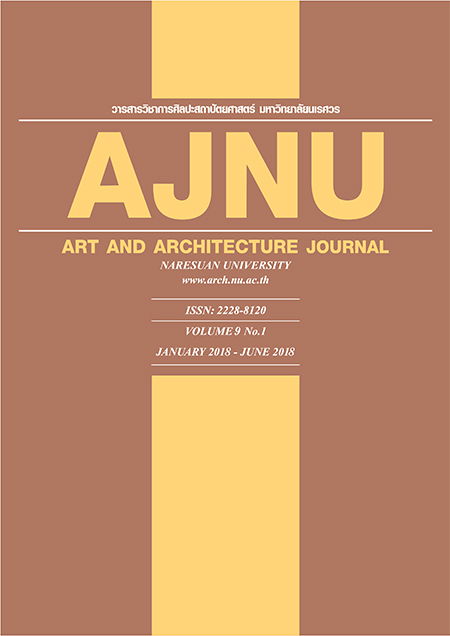เครื่องปั้นดินเผาสร้างสรรค์ : กรณีศึกษาเครื่องปั้นดินเผาประกอบไม้ยางพารา และเถาวัลย์ในจังหวัดสงขลา
Main Article Content
บทคัดย่อ
การวิจัยนี้ มีวัตถุประสงค์ คือ 1) ศึกษารูปแบบเครื่องปั้นดินเผาในอดีต ปัจจุบัน และกระบวนการผลิตของชาวสทิง
หม้อ 2) ศึกษาแนวทางการสร้างสรรค์ผลงานประติมากรรม 3) พัฒนาดินและศึกษารูปแบบ แนวคิด เทคนิค วิธีการ การทำ
เครื่องปั้นดินเผาประกอบไม้ยางพาราและเถาวัลย์โดยต่อยอดจากภูมิปัญญาท้องถิ่น 4) สร้างสรรค์ผลิตภัณฑ์เครื่องปั้นดินเผา
เป็นเอกลักษณ์เฉพาะตน กลุ่มตัวอย่างได้จากการสุ่มแบบเจาะจง คือ ผู้ผลิตเครื่องปั้นดินเผาบ้านสทิงหม้อ จำนวน 1 คน กลุ่ม
ผู้ประกอบการที่ขายสินค้าเครื่องปั้นดินเผาในอำเภอเมืองสงขลา 5 ร้านค้าและกลุ่มนักศึกษาหลักสูตรออกแบบ ชั้นปี3 ที่
ลงทะเบียนเรียนรายวิชาออกแบบเครื่องปั้นดินเผา รายวิชาวัสดุและกรรมวิธี และรายวิชาออกแบบของที่ระลึก 24 คน การวิจัย
พบว่า เครื่องปั้นดินเผาของชาวสทิงหม้อยังมีรูปแบบและกระบวนการผลิตแบบดั้งเดิมมีการปรับเปลี่ยนเล็กน้อยตามยุคสมัยซึ่งผู้วิจัย
ได้พัฒนาต่อยอดจากกระบวนการผลิตของชาวบ้าน และได้ศึกษาแนวทางในการสร้างสรรค์งานประติมากรรม โดยพัฒนา
วัสดุและกรรมวิธีการผลิตจากช่างชาวสทิงหม้อเพื่อให้ผลงานที่มีคุณค่า สามารถนำไปต่อยอดเพื่อการผลิตและจำหน่ายได้จริง
โดยกำหนดเกณฑ์ในการพัฒนาคือ วัสดุมีความคงทนแข็งแรงเหมาะกับประโยชน์ใช้สอย มีรูปแบบผลิตภัณฑ์สะท้อนให้เห็น
ความเป็นธรรมชาติและท้องถิ่นจังหวัดสงขลา และประเภทของผลิตภัณฑ์ที่ออกแบบสอดคล้องกับความต้องการของตลาด ใน
การทำเครื่องปั้นดินเผาประกอบไม้ยางพาราผู้วิจัยเลือกใช้ไม้ยางพาราที่ผ่านการใช้งานแล้ว เพราะมีราคาถูกและหาได้ง่าย แรง
บันดาลใจในการออกแบบผู้วิจัยได้มาจากธรรมชาติ และรูปทรงผลิตภัณฑ์แบบดั้งเดิมของชาวสทิงหม้อมาประยุกต์ใช้ในการ
ออกแบบผลิตภัณฑ์เครื่องปั้นดินเผาประกอบไม้ยางพาราและเถาวัลย์ ผลสรุปจากการพัฒนาดินให้สอดคล้องกับเทคนิคการเผา
ของผู้วิจัยสามารถสรุปได้ว่า ดินที่ผสมตามสัดส่วน ดินพื้นบ้าน : ดินเชื้อ ในอัตราส่วน 70 : 30 สามารถคงรูปได้เมื่อนำไปเผาแล้วทน
ความร้อน ไม่แตกหัก สามารถขึ้นรูปด้วยรูปทรงที่ซับซ้อนได้ และใช้งานได้จริง กรรมวิธีการผลิตสามารถผลิตได้โดยช่างพื้นบ้านนำไป
ต่อยอดเพื่อการผลิตและจำหน่ายได้


